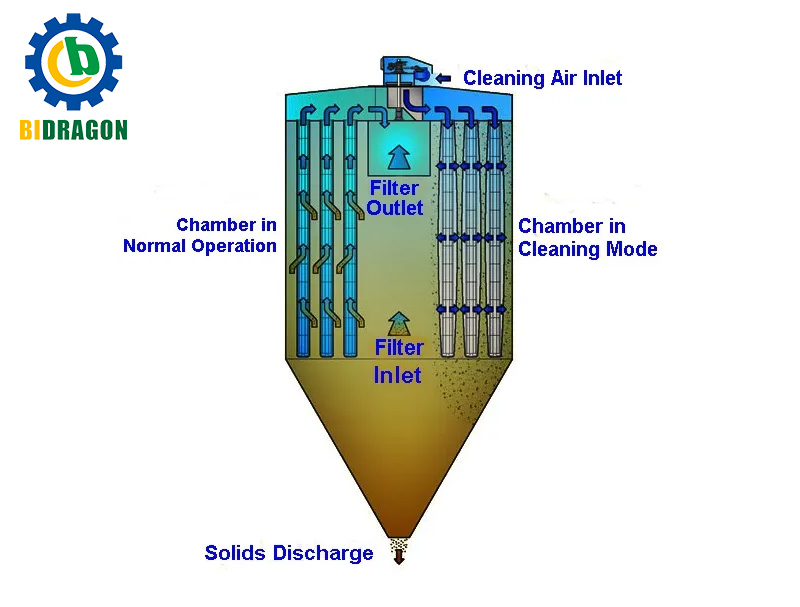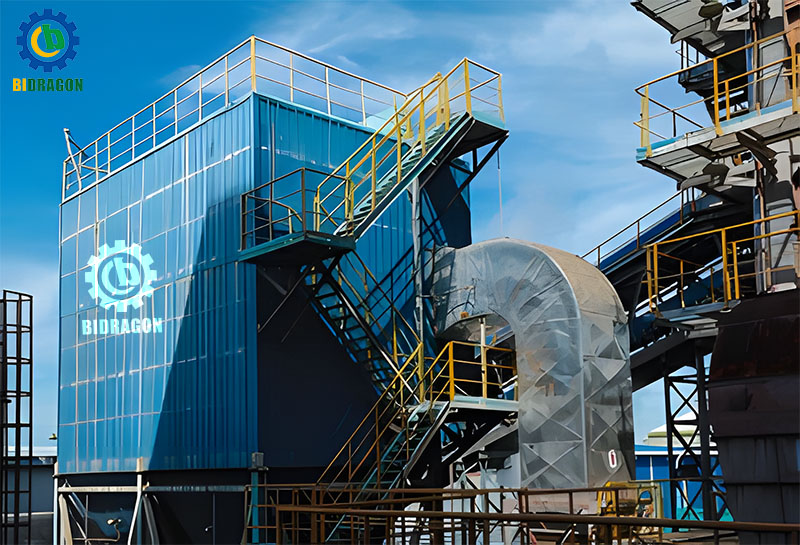Industrial boilers, as the core equipment for energy conversion, are widely used in many fields such as electric power production, chemical industry, textile, etc., undertaking the key task of converting fuel chemical energy into heat energy. However, in the process of fuel combustion, the boiler will produce a large number of flue gas containing dust, soot, particles and other pollutants, these pollutants will not only cause serious pollution of the atmospheric environment, triggering haze, acid rain and other environmental problems, but also pose a threat to the health of workers who are permanently exposed to the working environment, such as leading to respiratory diseases, pneumoconiosis and so on. In this context, “what role does the bag filter actually play in the boiler?” This question is of paramount importance, as it relates to the ability of a boiler system to achieve efficient energy conversion while taking into account environmental protection and production safety.
What is a Bag Filter?
A boiler bag filter, also known as a baghouse, is a highly efficient gas-solid separation device. Its core component is the filter bag, through the filtering effect of the bag, the particles in the flue gas will be intercepted to realize the purification of flue gas. In practical application scenarios, baghouse filters are widely used in power plants, cement plants, steel mills and other industries. For example, in power plants, a large amount of dusty flue gas produced by coal-fired boilers needs to be treated by bag filters to reduce pollutant emissions. Its working principle can be briefly summarized as follows: when the dusty flue gas enters the filter, under the action of the airflow, the particles are captured by the filter bag fibers, and the clean flue gas is discharged through the filter bag, so as to achieve the purpose of purifying the flue gas.

The specific role of bag filter in the boiler
a. Removal of particulate matter (PM)
Bag filter mainly removes particulate matter through the filter bag structure. The filter bag is made of special fiber material, the surface is finely treated, and the pore size is uniform and precisely controllable. These pores are able to act like a sieve to intercept dust, soot and particles in the flue gas one by one. Large particulate matter is first blocked by the surface of the filter bag, smaller particles are inertia, diffusion and other effects, collision with the fiber and attached to it. After such a filtration process, the particulate content of the flue gas discharged is significantly reduced, thus significantly improving the surrounding air quality. For workers who work around the boiler for long periods of time, the improvement in air quality is crucial. The reduction of respirable particulate matter effectively reduces the risk of respiratory illnesses and provides a strong safeguard for workers' health.
b. Protection of boiler components
Uneffectively filtered flue gas contains a large number of pollutants, such as acid gases and heavy metal particles. These pollutants circulate with the flue gas inside the boiler and are easily deposited on the surfaces of internal boiler components. Over time, this can lead to corrosion of components and damage the integrity of the metal structure. At the same time, the accumulation of pollutants may also lead to clogging of pipes, heat exchangers and other components. Bag filters effectively intercept these contaminants, significantly reducing the amount of contaminants entering the boiler interior. By reducing the risk of corrosion of components, it ensures a smooth heat transfer process and avoids the loss of heat transfer efficiency due to clogging. When the inside of the boiler is always clean, thermal efficiency is improved, energy is utilized more fully, and the operating costs of the business are reduced, as well as maintenance costs and downtime due to damaged components.
c. Ensuring environmental compliance
In the current environmental situation, environmental regulations in various countries are constantly being tightened. Represented by international standards such as ISO 14000, strict limit values have been set for industrial pollutant emissions. These standards cover the emission concentration and total amount requirements for a variety of pollutants such as particulate matter, sulfur dioxide, nitrogen oxides and other pollutants. As an important environmental protection equipment for boiler system, bag filter can precisely control pollutant emissions. Through high-efficiency filtration, the pollutant content in the boiler flue gas is reduced to the range permitted by the regulations. By adopting bag filters, enterprises can not only avoid facing high fines from environmental protection departments for exceeding emission standards, but also establish a good corporate image, win social recognition, and safeguard normal operation and sustainable development of enterprises.
d. Extend the service life of boilers
The service life of the boiler depends largely on the degree of internal cleanliness. During long-term operation, if the particles in the flue gas continue to erode the internal structure of the boiler, it will accelerate the wear and corrosion of components. Bag filters provide continuous filtration, keeping particles out of the flue gas and reducing their erosion of the boiler's internal structure. By reducing wear and corrosion, the performance of boiler components is stabilized and the overall operating life is significantly increased. This means that enterprises do not need to frequently replace boiler equipment, saving a lot of equipment acquisition costs, but also reduces the additional costs incurred in the process of equipment replacement and the loss of production interruptions.
Detailed explanation of the working mechanism of bag filter
The filter bag is the core component of the bag filter to capture particles. When the dust-containing flue gas passes through the filter bag, the particles will be captured by the bag fibers due to inertial collision, interception, diffusion and other effects. As filtration proceeds, a layer of dust will form on the surface of the filter bag, further enhancing the filtration effect. In order to prevent the filter bag due to excessive dust accumulation and affect the filtration efficiency, the need to use the blowback cleaning method, commonly used is compressed air pulse cleaning. Through the instantaneous release of high-pressure compressed air, the filter bag vibration, will be attached to the surface of the filter bag dust shake down to the dust collection bucket. The dust collected in the dust collection hopper is discharged from the filter periodically through the ash removal device. Under normal operation, the removal efficiency of bag filter for particles is up to 99.9%, which can realize efficient flue gas purification.
Comparison of different types of boiler bag filters
a. Pulse Jet Bag Filter
Pulse Jet Bag Filter (Pulse Jet Bag Filter) has a compact structure, and its pulse cleaning system realizes the cleaning of the filter bag through instantaneous blowing of compressed air, which is simple to operate and easy to maintain. This type of filter is suitable for handling flue gas with high dust concentration and is widely used in power plants, steel mills and other industries. Due to its high efficiency dust cleaning ability, it can maintain stable filtration performance even under high dust load.
b. Reverse Air Bag House
Reverse Air Bag House (Reverse Air Bag House) does not require compressed air and utilizes reverse airflow to clean the filter bags, making it suitable for use in applications where compressed air supply is inconvenient. Its unique design makes it suitable for large space, multi-compartment dust removal system, can be divided into compartments by means of rotating dust removal, to ensure the continuous operation of the system, in some of the old industrial plant renovation or specific production environment has the advantage.
c. Cartridge Collectors
Cartridge Collectors use filter cartridges instead of traditional filter bags and are suitable for fine dust removal and high air velocity environments. Cartridges are quick and easy to replace and have a small footprint, saving space in the installation. Cartridge dust collectors play an important role in industries that require high dust removal accuracy, such as electronics and pharmaceuticals, as well as in production sites where space is limited.

Design and Manufacturing Key Factors
CFM (cubic feet per minute), an important measure of air flow, is critical in bag filter design. Proper CFM design ensures that the filter matches the flue gas flow rate of the boiler system and guarantees the filtration effect. The choice of filter bag material directly affects the performance of the filter, and common filter bag materials include synthetic fiber, fiberglass and so on. Synthetic fiber filter bags have good abrasion resistance and chemical stability, suitable for general working conditions; glass fiber filter bags have outstanding high-temperature resistance and can be used to deal with high-temperature flue gas. In addition, the design of vacuum pressure and air/cloth ratio needs to be calculated accurately to ensure the stable operation of the filter under different working conditions. The design of suction hood not only affects the filtration efficiency, but also relates to the safety of the operator. Reasonable suction hood design can effectively guide the flue gas into the filter to avoid dust spillage.
Summary of bag filter advantages
Bag filter is characterized by high filtration efficiency, whether it is low-resistive dust or high-resistive dust, it can achieve high efficiency filtration. It is not sensitive to airflow fluctuations, and can maintain stable filtration performance during boiler operation even if the flue gas flow rate changes to some extent. In terms of operation, the control and operation of the bag filter is relatively simple, without the need for complex operating procedures. Maintenance is also more convenient, and there are mature technologies and processes for filter bag replacement and equipment overhaul. In addition, through the selection of appropriate filter bag materials and structural design, bag filters can also handle high-temperature, corrosive flue gas to meet the needs of different industrial applications.
Use of cost and maintenance considerations
When using bag filters, the initial investment mainly includes equipment procurement, installation and commissioning costs. Although the initial investment is relatively high, in the long run, the energy-saving effect and equipment protection it brings can significantly reduce operating costs. For example, by improving the thermal efficiency of the boiler, energy consumption is reduced; the service life of the boiler and other components is extended, and maintenance and replacement costs are reduced. In the course of use, common failures include broken filter bags and malfunctions in the ash-cleaning system. In view of these problems, the filter should be inspected and maintained on a regular basis, and the broken filter bag should be found and replaced in time to ensure the normal operation of the ash cleaning system. In order to extend the life of the filter bag, measures can be taken to control the flue gas temperature, avoid the flue gas mixed with corrosive substances, and at the same time, reasonably arrange the cleaning cycle to avoid excessive cleaning damage to the filter bag.
Conclusion
In industrial production, the operating efficiency of the boiler system and environmental protection are equally important. Bag filter as an indispensable part of the boiler system, as the human body's “lungs” as well, bear the important mission of purifying the flue gas and ensuring the stable operation of the system. It not only effectively reduces the emission of pollutants, protects the atmospheric environment and workers' health, but also brings significant economic benefits to enterprises by enhancing the thermal efficiency of the boiler and prolonging the life of the equipment. Therefore, enterprises are called upon to scientifically and reasonably select the appropriate bag filtration solution according to their own production characteristics and application scenarios, to realize a win-win situation for environmental protection and economic benefits, and to promote industrial production to the green and sustainable direction.























